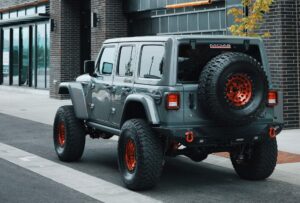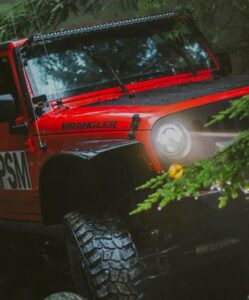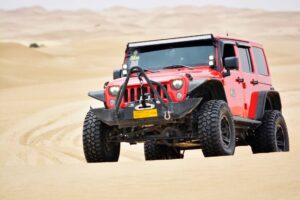Locking Hubs which are also called Freewheeling hubs are located in vehicles that support a four-wheel-drive system which gives the vehicle’s front wheel the ability to move freely when disconnected from the front axle shafts.
Locking Hubs helps to improve fuel efficiency, eliminate extra loads on the vehicle, and also save wear and tear on the vehicle and its components.
There are two different types of locking hubs which include; manual Locking Hub and automatic Locking Hub. Manual Locking Hubs are found in older vehicles that support the four-wheel-drive system, while automatic Locking Hubs are found in most of the modern vehicles.
Contents
Consequences of defective Locking Hubs
While locking hubs are durable and have a lot of advantages with time, they wear out and become defective. This might cause collateral damage to the vehicle components, like the shaft and the bearing and drivetrain wear.
Both manual and automatic locking hubs wear out and cause it not to engage or disengage properly. When a locking hub wears out or goes defective, it should be replaced since it cannot be fixed.
How To Identify a Defective Locking Hub?
When Locking Hubs become defective, while they are easy to replace, the damage they cause might not be. Some are very easy to detect but others might cause a handful before they are identified. Below are a few signs or steps to notice them.
- Locking Hubs will not Engage Properly
Once your locking hub is bad or defective your four-wheel-drive system will not engage properly or engage itself without your permission. When your locking hub is engaged your front wheel should be able to turn without the aid of your back wheel.
That means front wheels also receive engine power. But if it is damaged either both or one of your front wheels will not pull after engaging the locking hub and the four-wheel-drive system.
- Clicking Sound.
If your locking hub is bad, when engaged it will begin to make clicking or popping sounds while engaging or disengaging the wheel system. It might also make noises while starting the vehicle, making sharp turns, or coming to a halt.
- Not Disengaging Properly.
Bad locking hubs also lead to instant disengaging of the four-wheel system or fail to disengage and continue to behave as if it is in a four-wheel-drive system. Ultimately this will cause damage to the hub and lead to weird noises coming from the hub.
Sometimes the vehicle must be backed 5 feet or more to properly disengage the four-wheel system, so try backing your vehicle before assuming there is something wrong. Normally this happens due to four-wheel drive binding issues. You learn more about this by clicking here.
- Increase in Fuel Consumption.
Locking hubs are used to improve fuel efficiency and consumption. So, once you begin to notice a continuous increase in fuel consumption while 4WD is engaged, you might need to check the locking hub.
- Drivetrain Wear.
Bad locking hubs will lead to damage in bearing, shafts, axle, and sudden wearing out of front tires. Once the hub is damaged it will cause damage to the drivetrain components and wear them out. This will lead to damage to the vehicle as a whole.
Do Bad Locking Hubs Affect a Jeep Wrangler?
Yes, a bad locking hub will affect a jeep wrangler as it will cause damage to the four-wheel system disabling it to engage or disengage properly. It will also cause damage to the hub bearing, the axle, and the shaft. If it is not replaced quickly, it will affect the jeep’s drive train which would cost a lot to repair.
An increase in fuel consumption and wear out of the front tire and components of the front wheel of the jeep wrangler is part of the effects of a bad locking Hub.
Can a Jeep Wrangler Do Without Locking Hubs?
Like I said earlier locking hubs give 4WD vehicles front wheels the ability to move without the back wheels. Without this locking hub, you cannot possibly put your jeep wrangler into a four-wheel-drive system.
Without a locking hub, your wrangler fuel efficiency would not improve and there will be much mechanical resistance on the vehicle. Due to the continuous force and mechanical resistance while using your wrangler without a 4WD system due to no locking hubs your vehicle components will begin to wear out.
So, it is not advisable to remove or do without a locking hub for your jeep wrangler. Instead, get it replaced if damaged.
How To Replace a Defective Locking Hub
When your locking hub wears out or gets damaged, it is advisable to get it replaced quickly. Getting a new locking hub is easy, as different manufacturing companies produce both manual and artificial locking hubs.
There are a few steps or DIY instructions for people who know how to work their vehicle, while for others you could get a specialist in that area to help you out.
Below are steps on how to replace a locking hub;
- Firstly, get your vehicle on a level surface, making sure your vehicle does not lean or move out of position when jacked up
- After getting your vehicle on a level surface, get your jack and use it to lift the frontal area of your vehicle. If you do not know where to place the jack, go to the owner’s manual and check on the proper areas to place the jack
- Make sure the vehicle is raised enough so the front wheel can be removed without much effort
- Remove the front wheel assembly.
- Remove the locking hub cap from the hub body
- Remove the snap ring from the axle in the hub body
- Remove the locking hub components and inspect for the damaged components and part
- Install the new locking hub following this procedure in reverse.
Alternatively, you could get a specialist in this area to get it done for you.
Conclusion
Locking hubs are necessary and effective for jeep wranglers, as it helps in reducing fuel consumption, mechanical resistance, and extra load or force exerted on the vehicle. Locking hubs are of two types but both provide the same assistance to 4WD vehicles.
They also wear out due to mud or worn-out parts, and worn-out locking hubs can cause damage to other parts of the vehicle including the drive train. Worn-out locking hubs cannot be repaired but can be replaced.
If you think this guide may be helpful for some one else, You can share this with them. You just have to hit one of the share buttons below!
Peace!!



